Abstract
OBJECTIVE--To provide reliable prognostic information for couples seeking assisted conception. DESIGN--Analysis of four years' practice (1988-91). SETTING--Private university service linked with NHS reproductive medicine services. PATIENTS--804 couples with various causes of subfertility, median duration five years, median age of women 34 years. INTERVENTIONS--1280 completed cycles: 950 in vitro fertilisation, 144 gamete intrafallopian transfer, and 186 intrauterine insemination and superovulation. MAIN OUTCOME MEASURES--Pregnancy and birth rates per cycle and cumulative pregnancy and take home baby rates per couple. RESULTS--In women under 40 years and men with normal sperm, whatever the cause of infertility, results with in vitro fertilisation improved steadily reaching a pregnancy rate per cycle of 30% (95% confidence interval 26% to 35%) during 1990-1 and birth rate per cycle of 29% (23% to 35%) in 1990. Pregnancy and birth rates for gamete intrafallopian transfer were 36% (28% to 44%) and 26% (17% to 37%) and for intrauterine insemination 18% (12% to 24%) and 16% (10% to 22%). After six cycles cumulative probability of pregnancy was 82% and cumulative take home baby rate 70%. Considering only in vitro fertilisation and gamete intrafallopian transfer after four cycles the pregnancy rate was 78% (66% to 91%). CONCLUSIONS--Conception is less likely in women over 40 and men with sperm dysfunction. For other couples the prognosis for a live birth is at least as good as for fertile couples if they persist with treatment.
Full text
PDF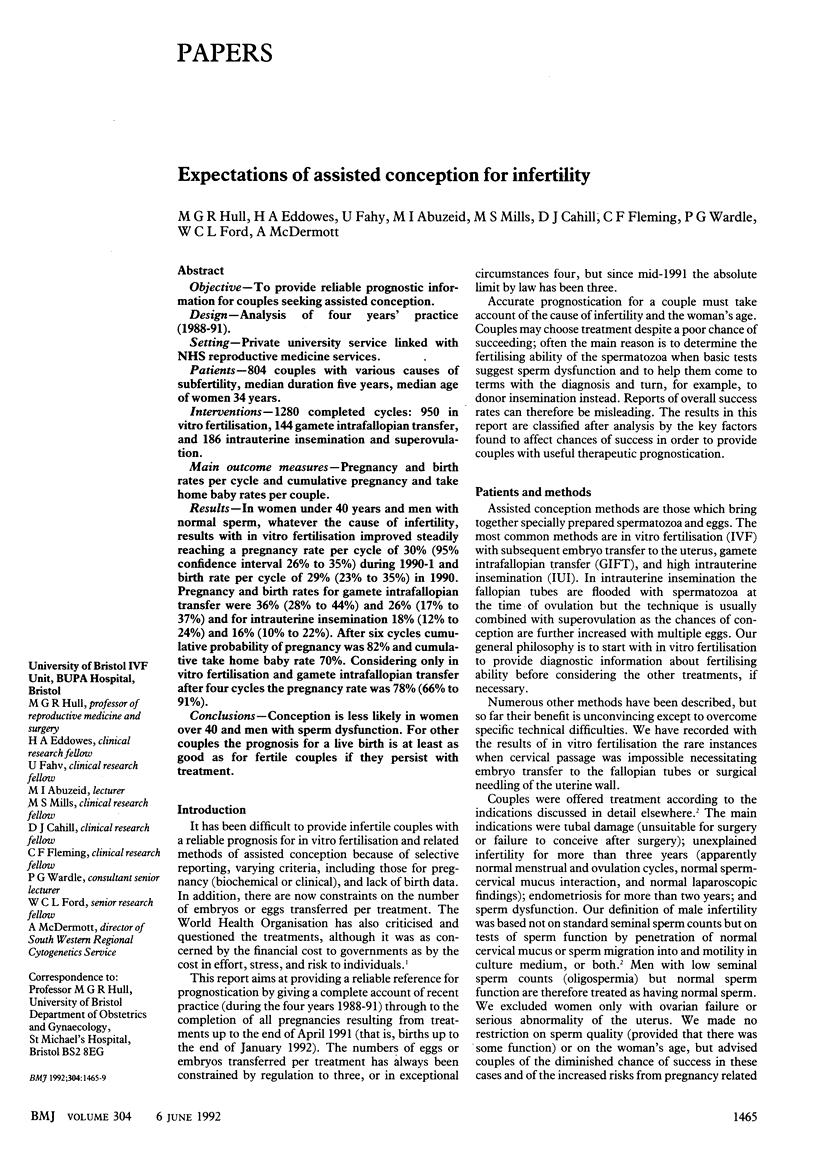
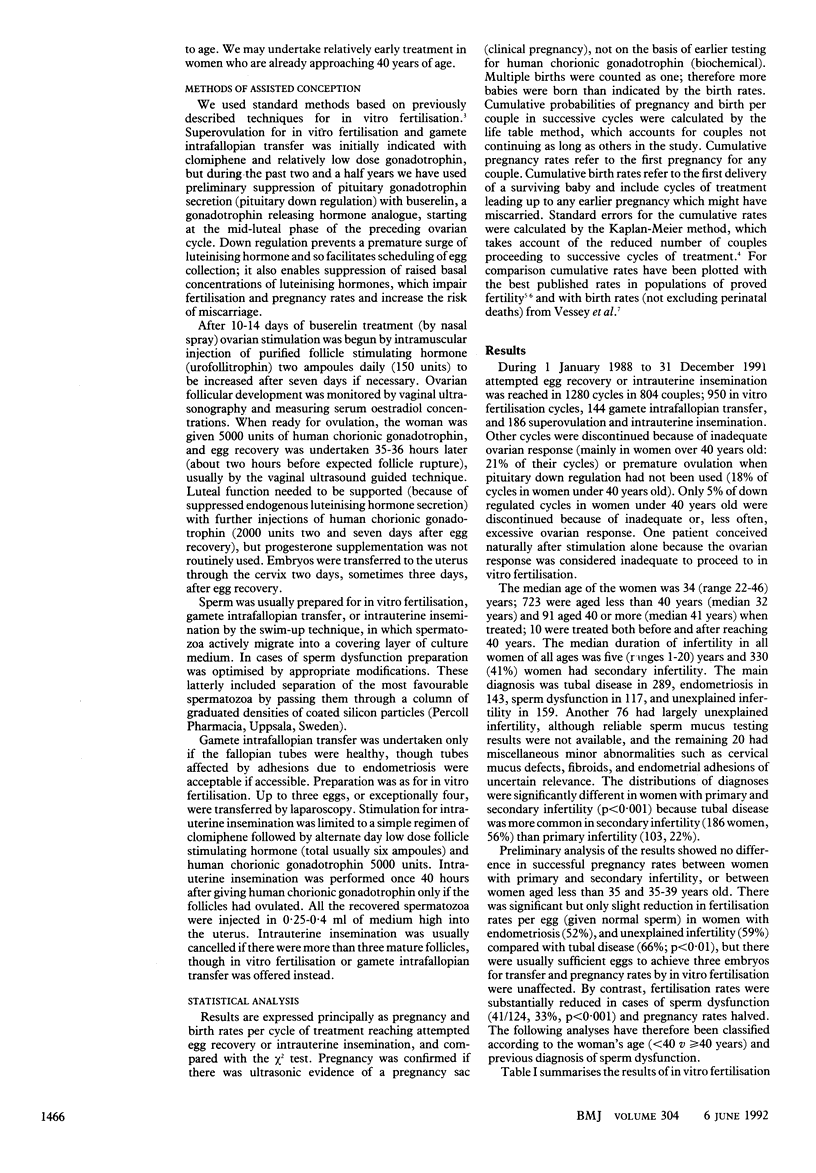
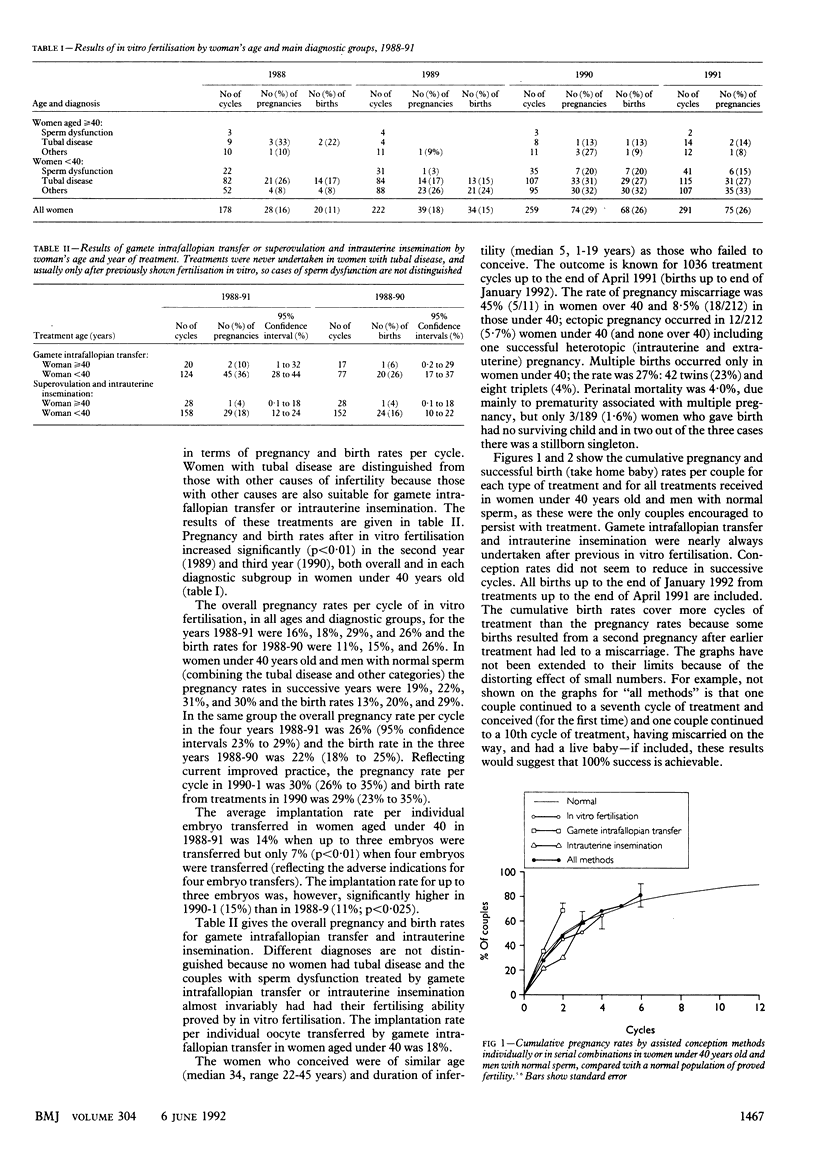
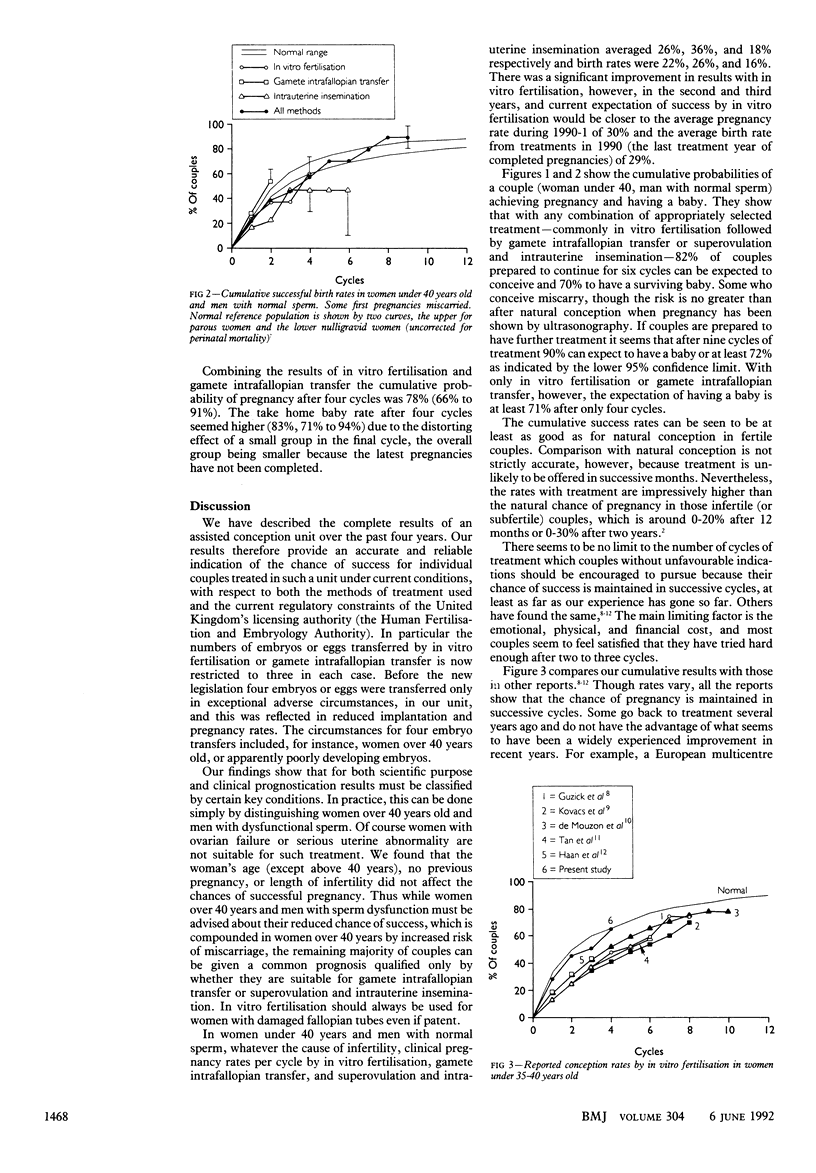
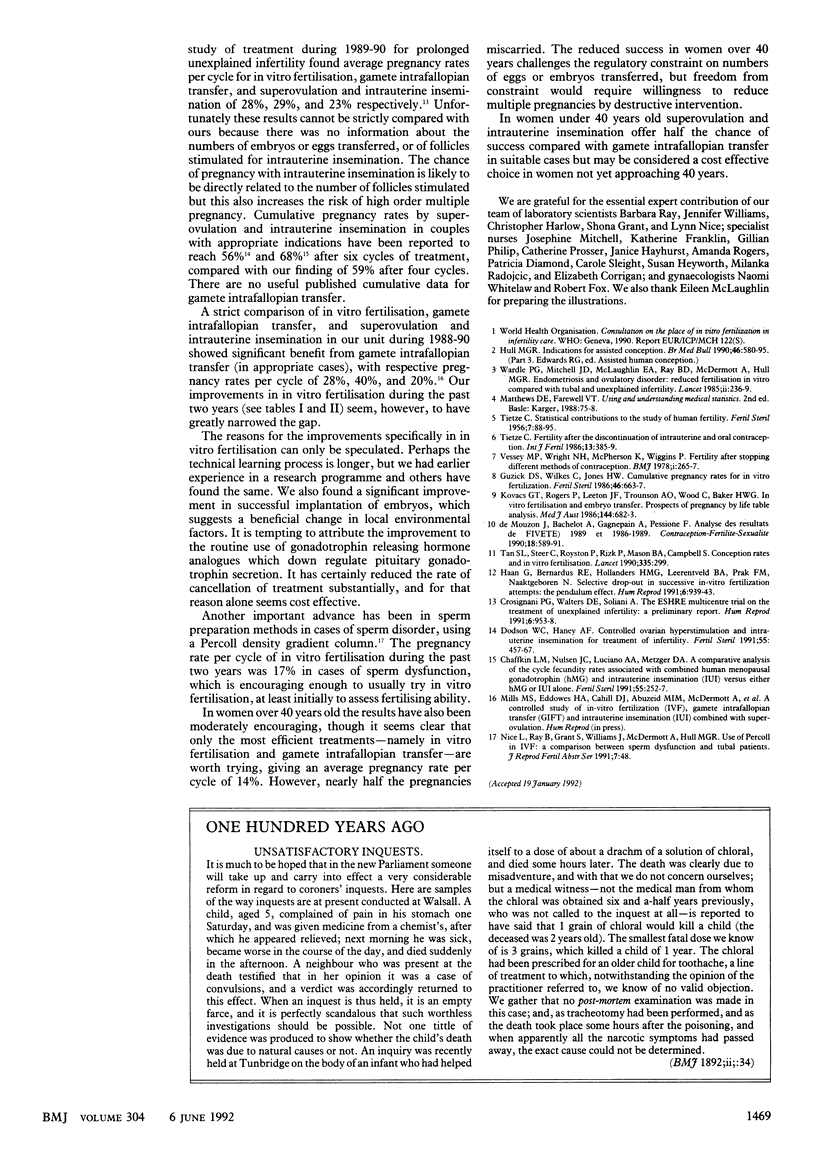
Selected References
These references are in PubMed. This may not be the complete list of references from this article.
- Chaffkin L. M., Nulsen J. C., Luciano A. A., Metzger D. A. A comparative analysis of the cycle fecundity rates associated with combined human menopausal gonadotropin (hMG) and intrauterine insemination (IUI) versus either hMG or IUI alone. Fertil Steril. 1991 Feb;55(2):252–257. doi: 10.1016/s0015-0282(16)54111-9. [DOI] [PubMed] [Google Scholar]
- Crosignani P. G., Walters D. E., Soliani A. The ESHRE multicentre trial on the treatment of unexplained infertility: a preliminary report. European Society of Human Reproduction and Embryology. Hum Reprod. 1991 Aug;6(7):953–958. doi: 10.1093/oxfordjournals.humrep.a137468. [DOI] [PubMed] [Google Scholar]
- Dodson W. C., Haney A. F. Controlled ovarian hyperstimulation and intrauterine insemination for treatment of infertility. Fertil Steril. 1991 Mar;55(3):457–467. doi: 10.1016/s0015-0282(16)54168-5. [DOI] [PubMed] [Google Scholar]
- Guzick D. S., Wilkes C., Jones H. W., Jr Cumulative pregnancy rates for in vitro fertilization. Fertil Steril. 1986 Oct;46(4):663–667. doi: 10.1016/s0015-0282(16)49645-7. [DOI] [PubMed] [Google Scholar]
- Haan G., Bernardus R. E., Hollanders H. M., Leerentveld B. A., Prak F. M., Naaktgeboren N. Selective drop-out in successive in-vitro fertilization attempts: the pendulum danger. Hum Reprod. 1991 Aug;6(7):939–943. doi: 10.1093/oxfordjournals.humrep.a137465. [DOI] [PubMed] [Google Scholar]
- Hull M. G. Indications for assisted conception. Br Med Bull. 1990 Jul;46(3):580–595. doi: 10.1093/oxfordjournals.bmb.a072418. [DOI] [PubMed] [Google Scholar]
- Kovacs G. T., Rogers P., Leeton J. F., Trounson A. O., Wood C., Baker H. W. In-vitro fertilization and embryo transfer. Prospects of pregnancy by life-table analysis. Med J Aust. 1986 Jun 23;144(13):682–683. [PubMed] [Google Scholar]
- TIETZE C. Statistical contributions to the study of human fertility. Fertil Steril. 1956 Jan-Feb;7(1):88–95. doi: 10.1016/s0015-0282(16)32231-2. [DOI] [PubMed] [Google Scholar]
- Tan S. L., Steer C., Royston P., Rizk P., Mason B. A., Campbell S. Conception rates and in-vitro fertilisation. Lancet. 1990 Feb 3;335(8684):299–299. doi: 10.1016/0140-6736(90)90126-p. [DOI] [PubMed] [Google Scholar]
- Tietze C. Fertility after discontinuation of intrauterine and oral contraception. Int J Fertil. 1968 Oct-Dec;13(4):385–389. [PubMed] [Google Scholar]
- Vessey M. P., Wright N. H., McPherson K., Wiggins P. Fertility after stopping different methods of contraception. Br Med J. 1978 Feb 4;1(6108):265–267. doi: 10.1136/bmj.1.6108.265. [DOI] [PMC free article] [PubMed] [Google Scholar]
- Wardle P. G., Mitchell J. D., McLaughlin E. A., Ray B. D., McDermott A., Hull M. G. Endometriosis and ovulatory disorder: reduced fertilisation in vitro compared with tubal and unexplained infertility. Lancet. 1985 Aug 3;2(8449):236–239. doi: 10.1016/s0140-6736(85)90289-2. [DOI] [PubMed] [Google Scholar]


